Coupled Hydromechanical Modeling and Assessment of Induced Seismicity at FWU: Utilizing Time-Lapse VSP and Microseismic Data
Abstract
:1. Introduction
2. Background Study
3. Field Description
3.1. Site Description
3.2. Geology of the Area
3.3. Acquisition of Field Data
3.4. Microseismic Data
4. Materials and Methods
4.1. Numerical Simulation Model Setup
4.2. Coupled Modeling
4.2.1. Fracture Plane Failure Criteria
4.2.2. Microseismic Modeling
4.2.3. Computation of Moment Magnitudes
4.2.4. Fracture Parameterization
5. Simulation Results
5.1. Effects of Injection Rates, Bottomhole Pressure on Microseismic Occurrences
5.2. Main Geomechanics and Sector Model Calibration
5.3. Events within Morrow B Sandstone
5.4. Sensitivity Study on Fault Properties
5.5. Moment Magnitudes Computation Results
6. Discussion
6.1. Stratigraphy
6.2. Fluid Injection
6.3. Analysis on Microseismic Modeling
7. Conclusions
- A manual framework for integrating multidisciplinary data to improve stress prediction of the Morrow B using VSP and microseismic data were developed. The mechanical earth model was initially calibrated using the VSP data, which carries the combined effect of fluid substitution and stress changes on the seismic velocities. Integration of microseismic data allowed for further constraint of the model. To assess the impact of key model parameters on the stress calibration, the integration framework can be automated and several simulation cases could be run.
- Having prior knowledge of the microseismic event locations and adding fractures at these locations were useful in the geomechanical stress modeling and prediction. This procedure required the reservoir engineer to specify fault locations within the geomechanical model before running for failure. Moment magnitudes computed were within the same magnitude for events in the Morrow B, suggesting the suitability of this approach. Nonetheless, the coupled hydro-geomechanical model could be run for plastic failure and regions of deformations are identified and compared to the known microseismic event locations.
- The magnitudes of the microseismic events observed in the FWU are not large enough to cause safety concerns. The absence of active faults within the Morrow B and the presence of an underlying Morrow shale could be a major contributing factor to the occurrence of low magnitudes microseismic events.
Author Contributions
Funding
Data Availability Statement
Conflicts of Interest
References
- Intergovernmental Panel on Climate Change. Climate Change 2022—Mitigation of Climate Change; Full Report; IPCC: Geneva, Switzerland, 2022. [Google Scholar]
- Bradshaw, J.; Zhenlin, C.; Amit, G.; Dario, G.; Rogner, H.; Simbeck, D.; Williams, R. Sources of CO2—Intergovernmental Panel on Climate Change; World Meteorological Organization: Geneva, Switzerland, 2019. [Google Scholar] [CrossRef]
- Beck, L. The US Section 45Q Tax Credit for Carbon Oxide Sequestration: An Update; Global CCS Institute: Melbourne, Australia, 2020. [Google Scholar]
- Nagabhushan, D.; Russell, R.; Waltzer, K.; Thompson, J.; Beck, L.; Jaruzel, M. Carbon capture: Prospects and policy agenda for CO2-neutral power generation. Electr. J. 2021, 34, 106997. [Google Scholar] [CrossRef]
- Ampomah, W.; Balch, R.S.; Grigg, R.B.; McPherson, B.; Will, R.; Lee, S.Y.; Dai, Z.; Pan, F. Co-optimization of CO2-EOR and storage processes in mature oil reservoirs. Greenh. Gases Sci. Technol. 2017, 7, 128–142. [Google Scholar] [CrossRef]
- Jenkins, C.R.; Cook, P.J.; Ennis-King, J.; Undershultz, J.; Boreham, C.; Dance, T.; de Caritat, P.; Etheridge, D.M.; Freifeld, B.M.; Hortle, A.; et al. Safe storage and effective monitoring of CO2 in depleted gas fields. Proc. Natl. Acad. Sci. USA 2012, 109, E35–E41. [Google Scholar] [CrossRef] [PubMed]
- NETL (National Energy Technology Laboratory). Site Screening, Site Selection, and Site Characterisation for Geological Storage Projects. Best Practices. 2017. Available online: https://netl.doe.gov/sites/default/files/2018-10/BPM-SiteScreening.pdf (accessed on 28 March 2023).
- McClure, M.W.; Horne, R.N. Correlations between formation properties and induced seismicity during high pressure injection into granitic rock. Eng. Geol. 2014, 175, 74–80. [Google Scholar] [CrossRef]
- Tutuncu, A.N.; Bui, B.T. A coupled geomechanics and fluid flow model for induced seismicity prediction in oil and gas operations and geothermal applications. J. Nat. Gas Sci. Eng. 2016, 29, 110–124. [Google Scholar] [CrossRef]
- Skoumal, R.J.; Kaven, J.O.; Barbour, A.J.; Wicks, C.; Brudzinski, M.R.; Cochran, E.S.; Rubinstein, J.L. The induced MW 5.0 March 2020 West Texas seismic sequence. J. Geophys. Res. Solid Earth 2021, 126, e2020JB020693. [Google Scholar] [CrossRef]
- Pei, S.; Peng, Z.; Chen, X. Locations of Injection-Induced Earthquakes in Oklahoma Controlled by Crustal Structures. J. Geophys. Res. Solid Earth 2018, 123. [Google Scholar] [CrossRef]
- Zoback, M.D.; Lund Snee, J.E. Predicted and observed shear on preexisting faults during hydraulic fracture stimulation. In SEG Technical Program Expanded Abstracts; Society of Exploration Geophysicists: Houston, TX, USA, 2018; pp. 3588–3592. [Google Scholar] [CrossRef]
- McMillan, M.D. Stepwise Dynamic Calibration of a Hydromechanical Simulation Using Time-Lapse Vertical Seismic Profile. In ProQuest Dissertations and Theses; New Mexico Institute of Mining and Technology PP: Socorro, NM, USA, 2021. [Google Scholar]
- Chen, R.; Xue, X.; Park, J.; Datta-Gupta, A.; King, M.J. New insights into the mechanisms of seismicity in the Azle area, North Texas. Geophysics 2020, 85, EN1. [Google Scholar] [CrossRef]
- Adu-Gyamfi, B.; Ampomah, W.; Tu, J.; Sun, Q.; Erzuah, S.; Acheampong, S. Assessment of chemo-mechanical impacts of CO2 sequestration on the caprock formation in Farnsworth oil field, Texas. Sci. Rep. 2022, 12, 13023. [Google Scholar] [CrossRef]
- Acheampong, S.A.; Ampomah, W.; Khaniani, H.; Will, R.; Sarkodie-Kyeremeh, J. Quantitative interpretation of time-lapse seismic data at Farnsworth field unit: Rock physics modeling, and calibration of simulated time-lapse velocity responses. Greenh. Gases Sci. Technol. 2022, 12, 671–697. [Google Scholar] [CrossRef]
- Cather, M.; Rose-Coss, D.; Gallagher, S.; Trujillo, N.; Cather, S.; Hollingworth, R.S.; Mozley, P.; Leary, R.J. Deposition, diagenesis, and sequence stratigraphy of the Pennsylvanian Morrowan and Atokan intervals at Farnsworth Unit. Energies 2021, 14, 1057. [Google Scholar] [CrossRef]
- Xiao, T.; McPherson, B.; Esser, R.; Jia, W.; Dai, Z.; Chu, S.; Pan, F.; Viswanathan, H. Chemical Impacts of Potential CO2 and Brine Leakage on Groundwater Quality with Quantitative Risk Assessment: A Case Study of the Farnsworth Unit. Energies 2020, 13, 6574. [Google Scholar] [CrossRef]
- Asante, J.; Ampomah, W.; Rose-Coss, D.; Cather, M.; Balch, R. Probabilistic assessment and uncertainty analysis of CO2 storage capacity of the Morrow B Sandstone—Farnsworth field unit. Energies 2021, 14, 7765. [Google Scholar] [CrossRef]
- Rasmussen, L.; Fan, T.; Rinehart, A.; Luhmann, A.; Ampomah, W.; Dewers, T.; Heath, J.; Cather, M.; Grigg, R. Carbon storage and enhanced oil recovery in Pennsylvanian Morrow Formation clastic reservoirs: Controls on oil–brine and oil–CO2 relative permeability from diagenetic heterogeneity and evolving wettability. Energies 2019, 12, 3663. [Google Scholar] [CrossRef]
- Will, R.; Bratton, T.; Ampomah, W.; Acheampong, S.; Cather, M.; Balch, R. Time-Lapse Integration at FWU: Fluids, Rock Physics, Numerical Model Integration, and Field Data Comparison. Energies 2021, 14, 5476. [Google Scholar] [CrossRef]
- Munson, T.W. Depositional, Diagenetic, and Production History of the upper Morrowan Buckhaults Sandstone, Farnsworth Field Ochiltree County Texas; Datapages, Inc.: Tulsa, OK, USA, 1989; pp. 1–20. [Google Scholar]
- Ross-Coss, D.; Ampomah, W.; Cather, M.; Balch, R.; Mozley, P.; Rasmussen, L. An Improved Approach for Sandstone Reservoir Characterization. In Proceedings of the SPE Western Regional Meeting, Anchorage, AK, USA, 23–26 May 2016. [Google Scholar] [CrossRef]
- Gallagher, S. Depositional and Diagenetic Controls on Reservoir Heterogeneity: Upper Morrow Sandstone, Farnsworth Unit, Ochiltree County, Texas. Ph.D. Thesis, New Mexico Institute of Mining and Technology, Socorro, NM, USA, 2014. [Google Scholar]
- Moodie, N.; Ampomah, W.; Jia, W.; McPherson, B. Relative Permeability: A Critical Parameter in Numerical Simulations of Multiphase Flow in Porous Media. Energies 2021, 14, 2370. [Google Scholar] [CrossRef]
- van Wijk, J.; Hobbs, N.; Rose, P.; Mella, M.; Axen, G.; Gragg, E. Analysis of geologic CO2 migration pathways in Farnsworth Field, NW Anadarko Basin. Energies 2021, 14, 7818. [Google Scholar] [CrossRef]
- El-Kaseeh, G.; Czoski, P.; Will, R.; Balch, R.; Ampomah, W.; Li, X. Time-lapse vertical seismic profile for CO2 monitoring in carbon capture, utilization and sequestration/EOR, Farnsworth project. In Proceedings of the 2018 SEG International Exposition and Annual Meeting, SEG 2018, Anaheim, CA, USA, 14–19 October 2018; pp. 5377–5381. [Google Scholar] [CrossRef]
- Ma, T.; Lin, D.; Tang, C.; Yadav, K.P.; Feng, Z.; Ma, K. Microseismic Monitoring, Positioning Principle, and Sensor Layout Strategy of Rock Mass Engineering. Geofluids 2020, 2020, 8810391. [Google Scholar] [CrossRef]
- Ampomah, W.; Will, R.; Mcmillan, M.; Bratton, T.; Huang, L.; El-kaseeh, G.; Liu, X.; Li, J.; Lee, D. Improving Subsurface Stress Characterization for Carbon Dioxide Storage Projects. In Proceedings of the 15th Greenhouse Gas Control Technologies Conference, Abu Dhabi, United Arab Emirates, 15–18 March 2021; pp. 15–18. [Google Scholar]
- Gao, K.; Huang, L.; Qin, Y.; Chen, T.; Coblentz, D.; El-kaseeh, G.; Bratton, T. Adaptive full-waveform moment-tensor inversion of microseismic data. In Proceedings of the SEG/AAPG/SEPM First International Meeting for Applied Geoscience & Energy, Denver, CO, USA and online, 26 September–1 October 2021. [Google Scholar] [CrossRef]
- Ampomah, W.; Balch, R.S.; Ross-Coss, D.; Hutton, A.; Cather, M.; Will, R.A. An Integrated Approach for Characterizing a Sandstone Reservoir in the Anadarko Basin. Paper presented at the Offshore Technology Conference, Houston, TX, USA, 2–5 May 2016. [Google Scholar] [CrossRef]
- Schlumberger. VISAGE Reference Manual—Schlumberger Private; Schlumberger: Houston, TX, USA, 2018. [Google Scholar]
- Biot, M.A. General Theory of Three-Dimensional Consolidation. J. Appl. Phys. 1941, 12, 155–164. [Google Scholar] [CrossRef]
- Karimnezhad, M.; Jalalifar, H.; Kamari, M. Investigation of caprock integrity for CO2 sequestration in an oil reservoir using a numerical method. J. Nat. Gas Sci. Eng. 2014, 21, 1127–1137. [Google Scholar] [CrossRef]
- Kozlowska, M.; Brudzinski, M.; Friberg, P.; Skoumal, R.; Baxter, N.; Currie, B. Maturity of nearby faults influences seismic hazard from hydraulic fracturing. Proc. Natl. Acad. Sci. USA 2018, 115, 201715284. [Google Scholar] [CrossRef] [PubMed]
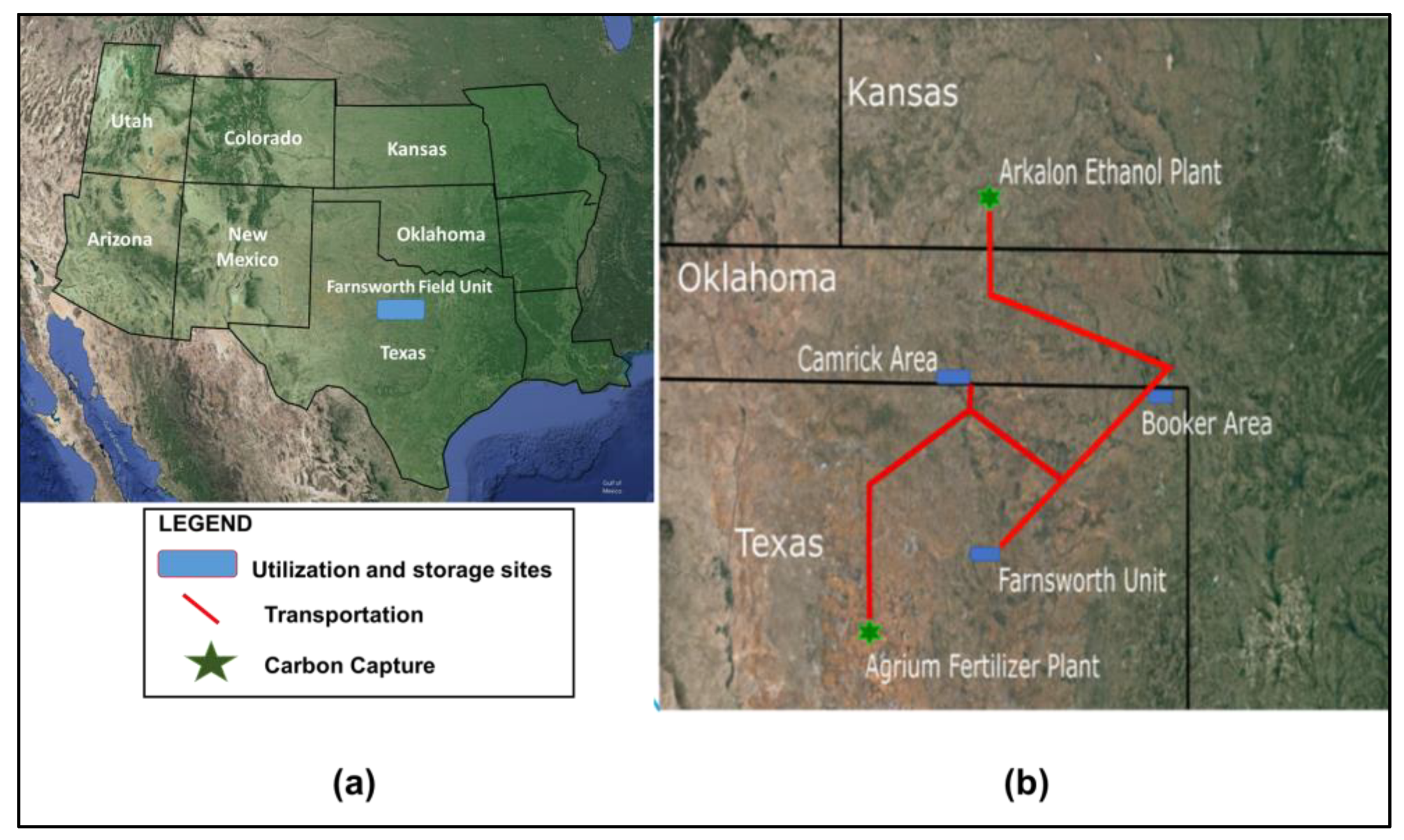

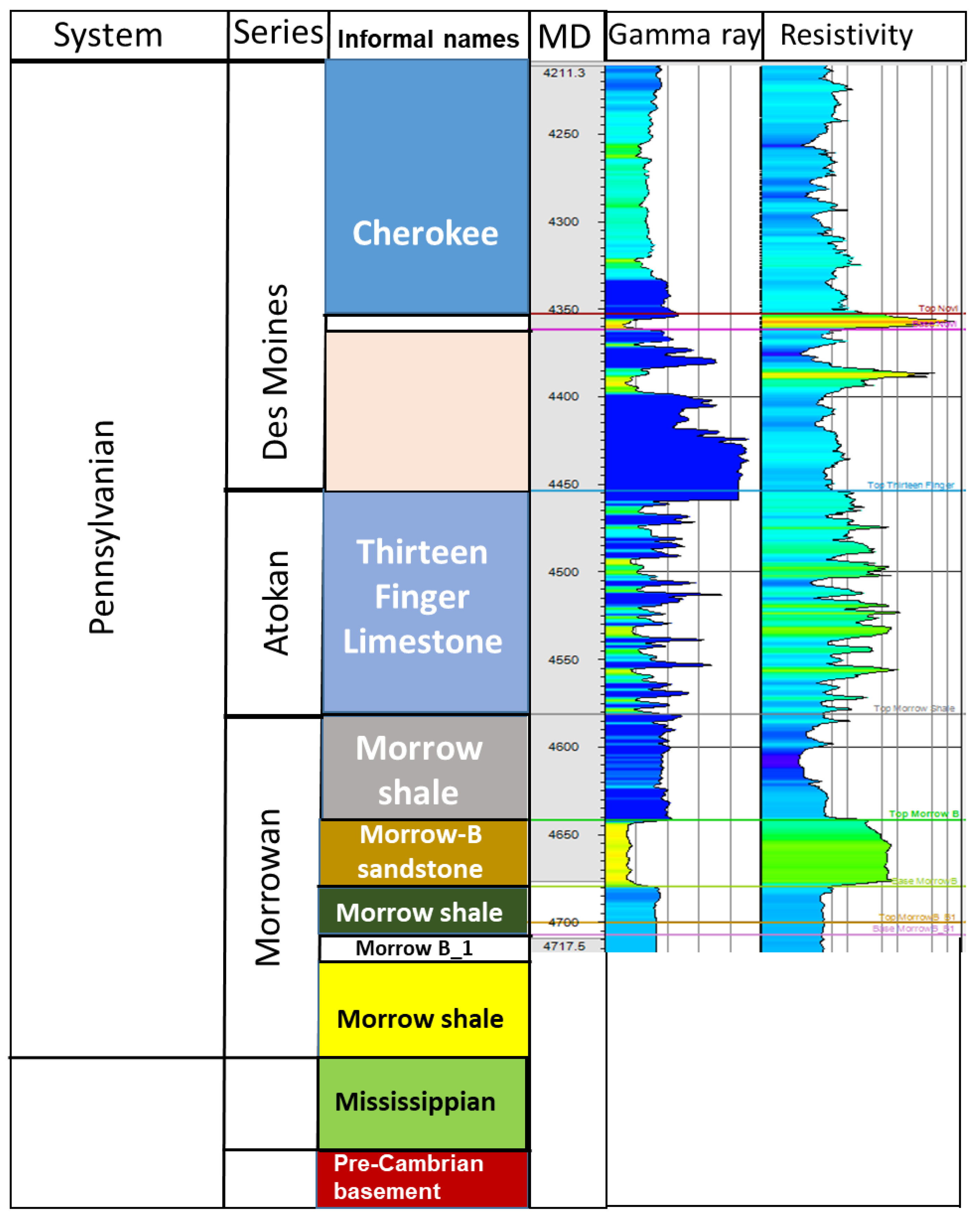

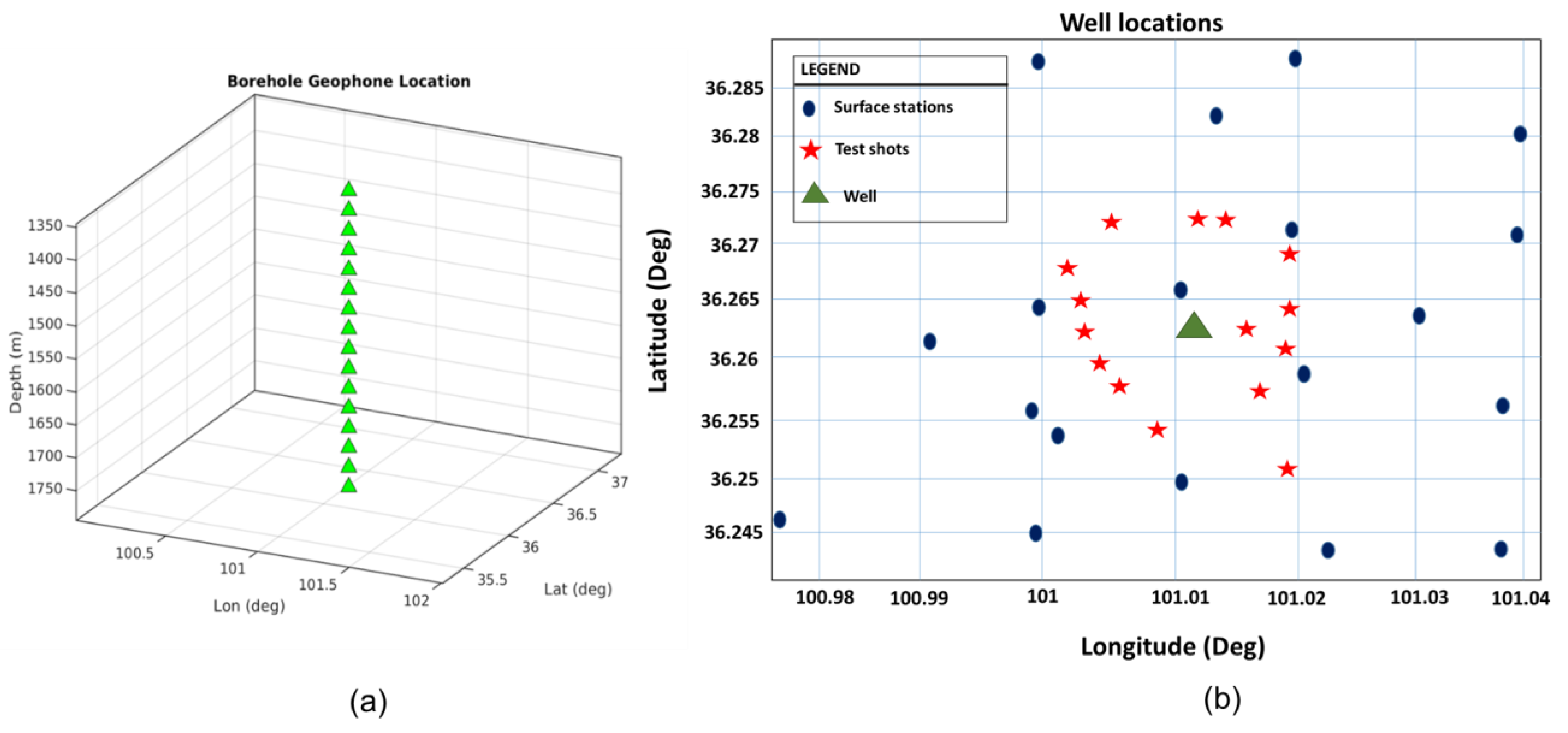
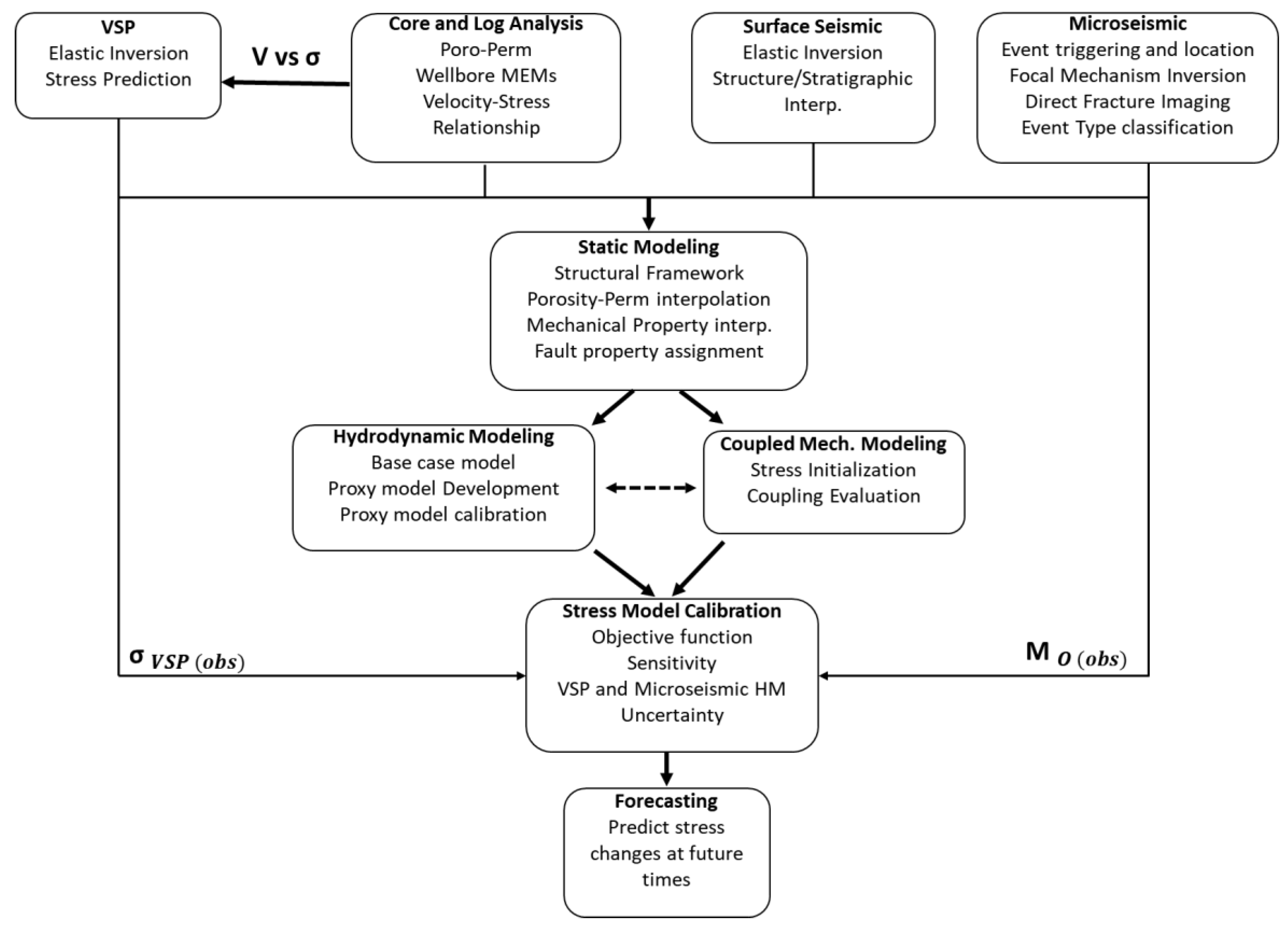
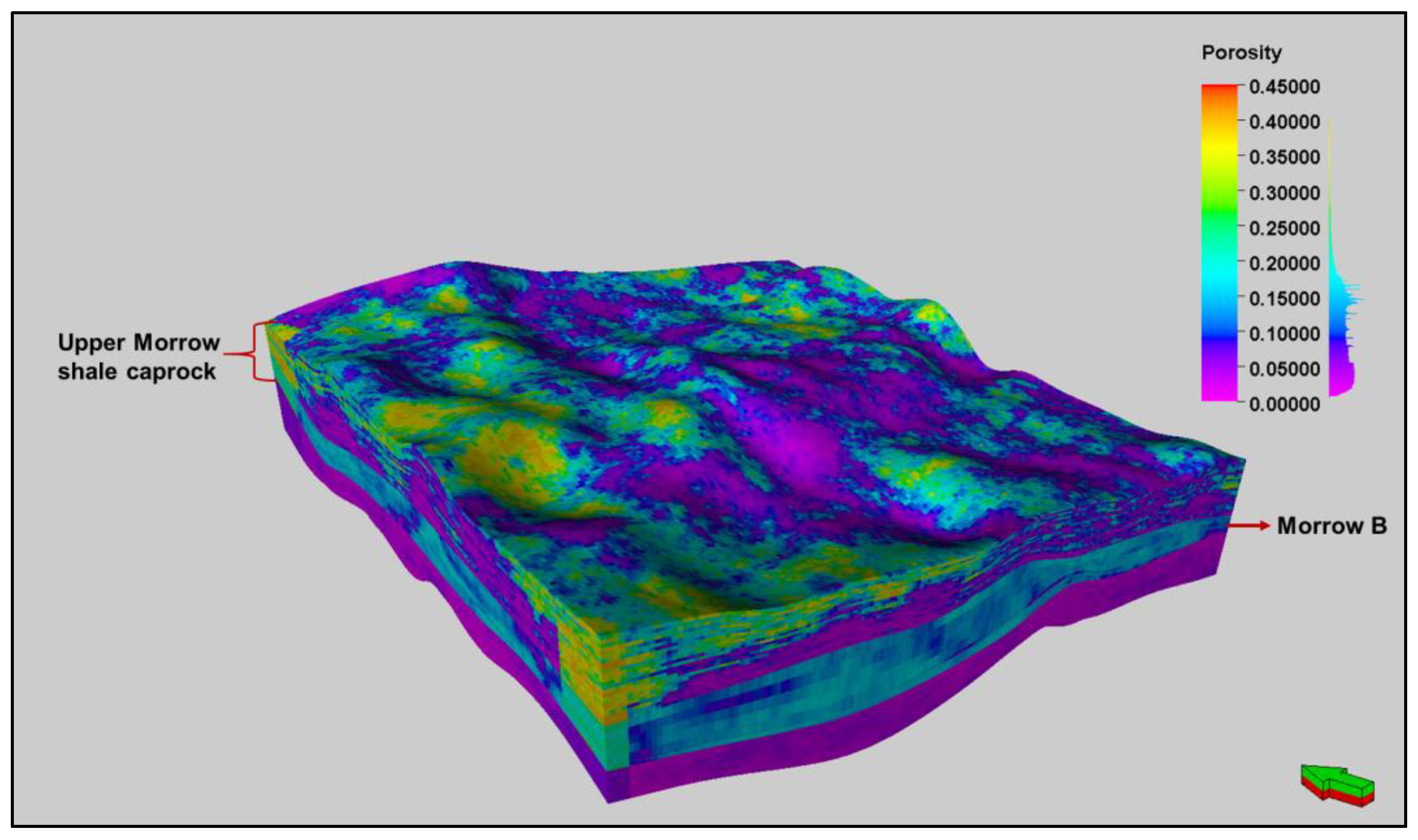
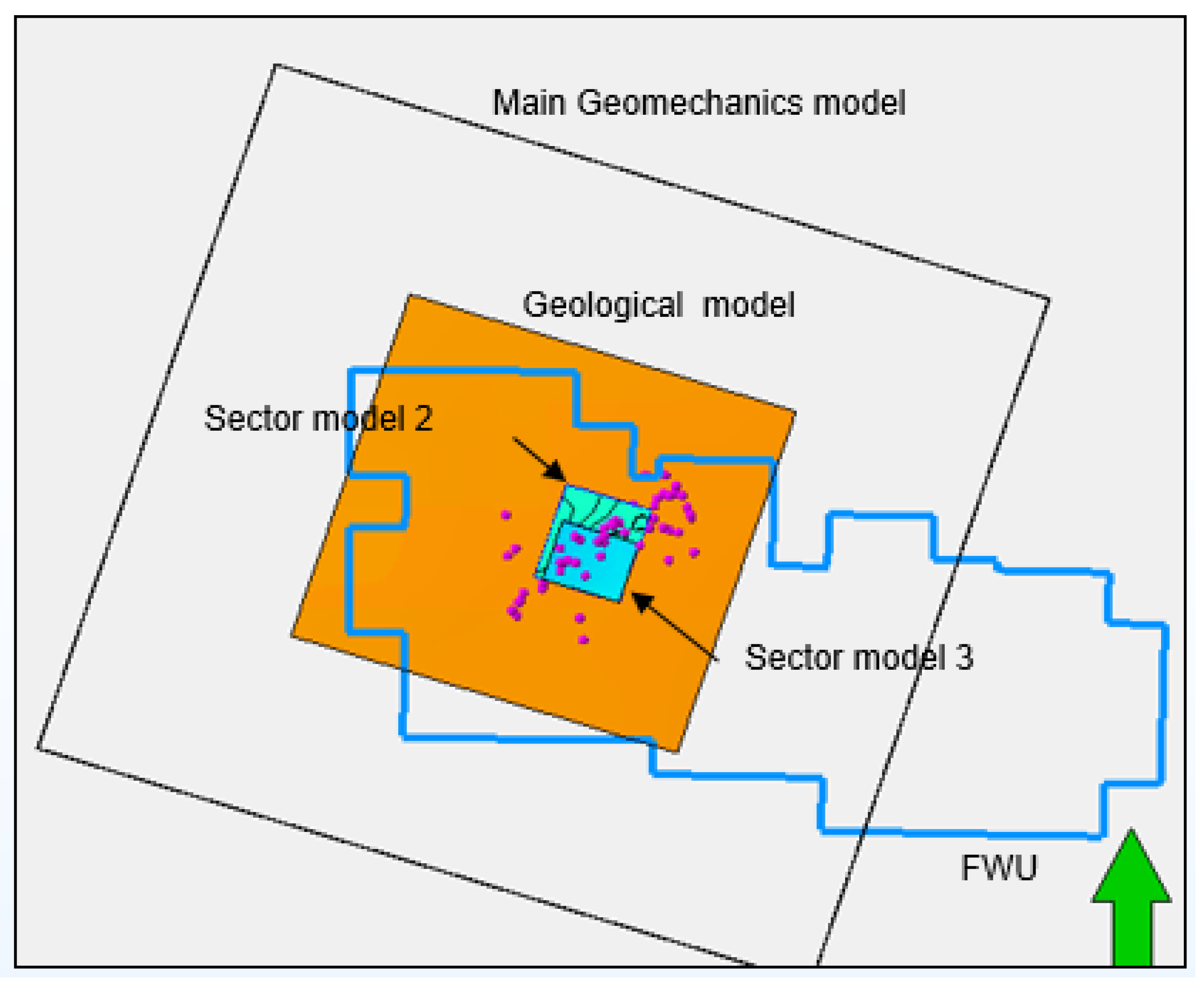
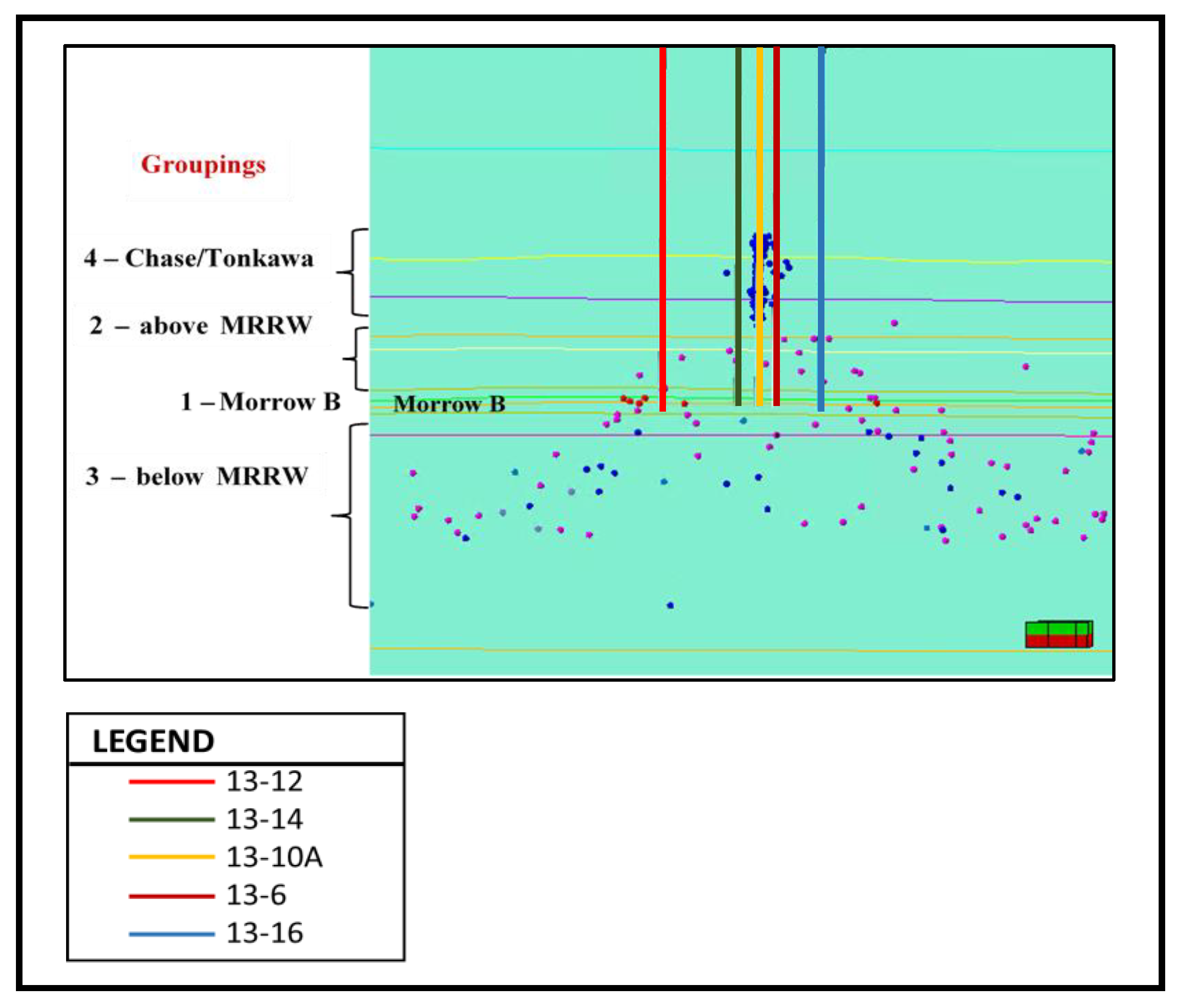
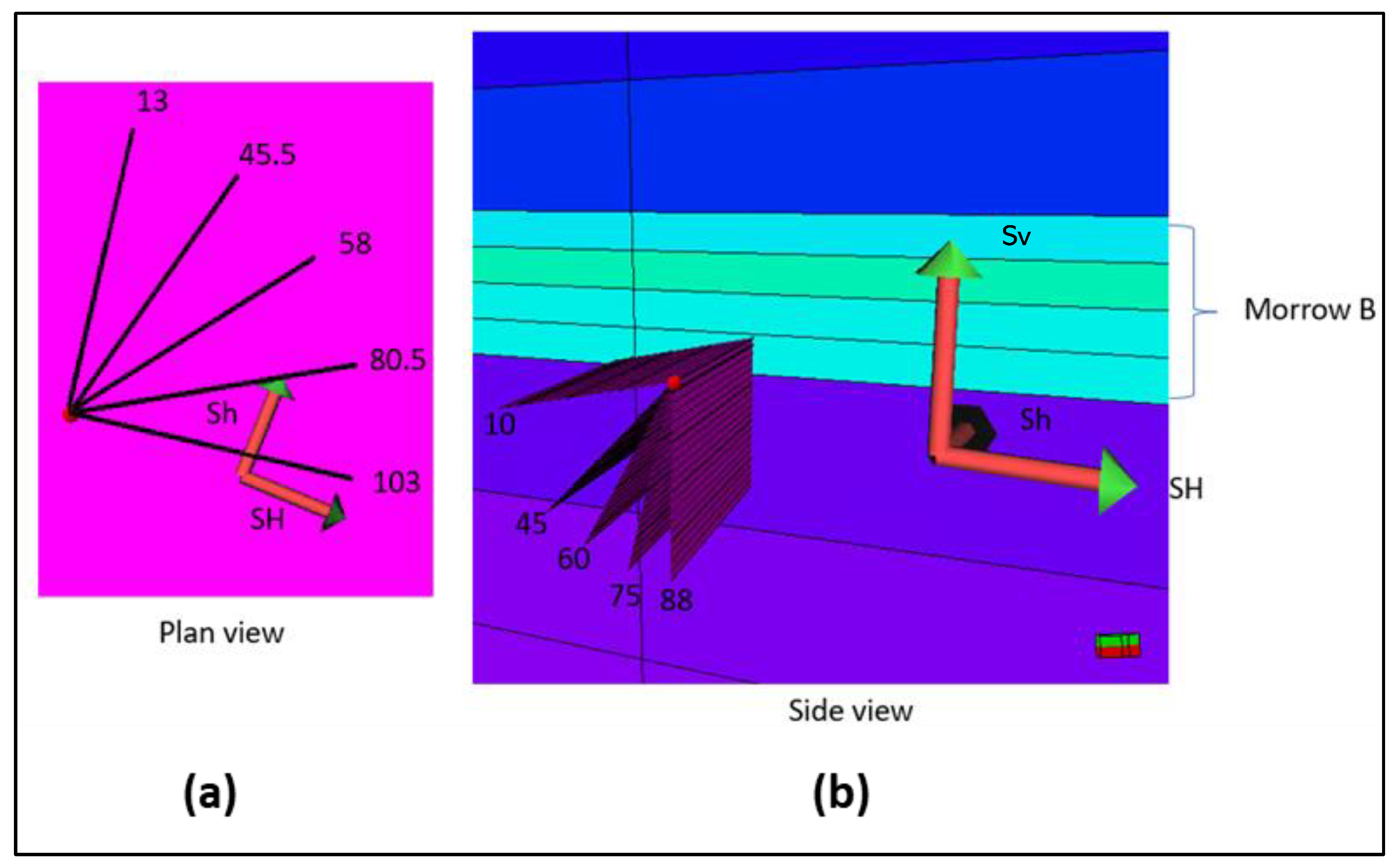

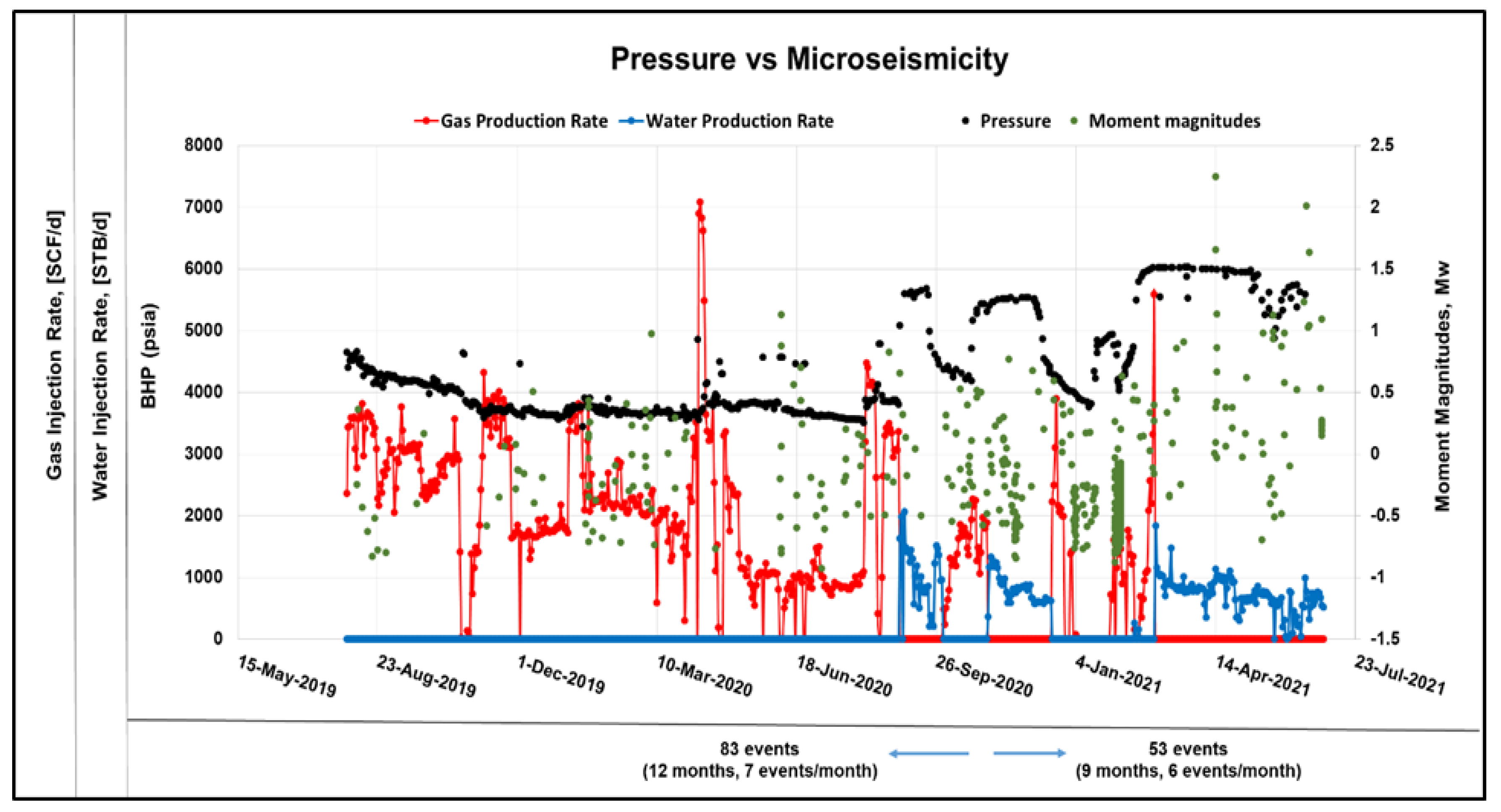

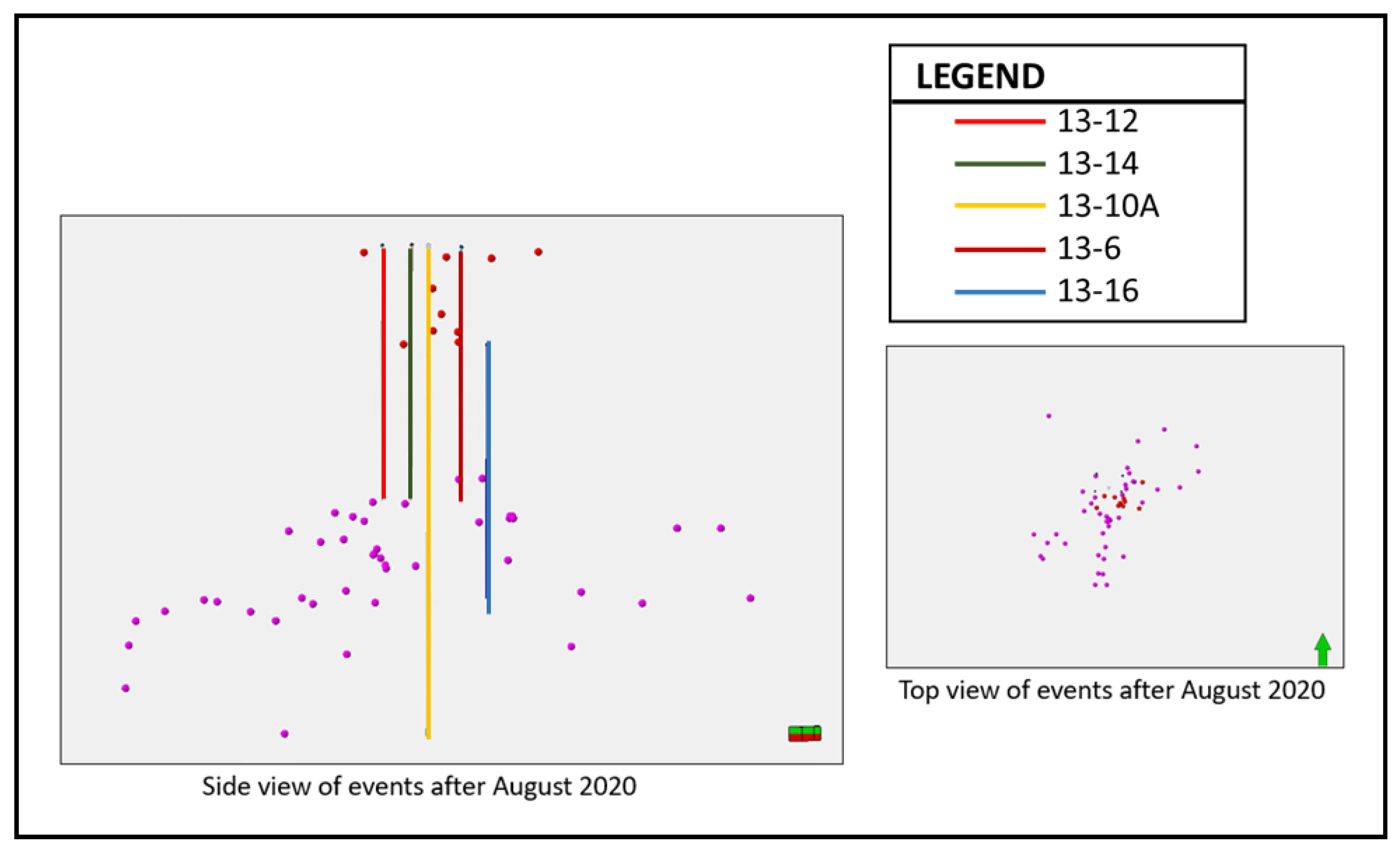
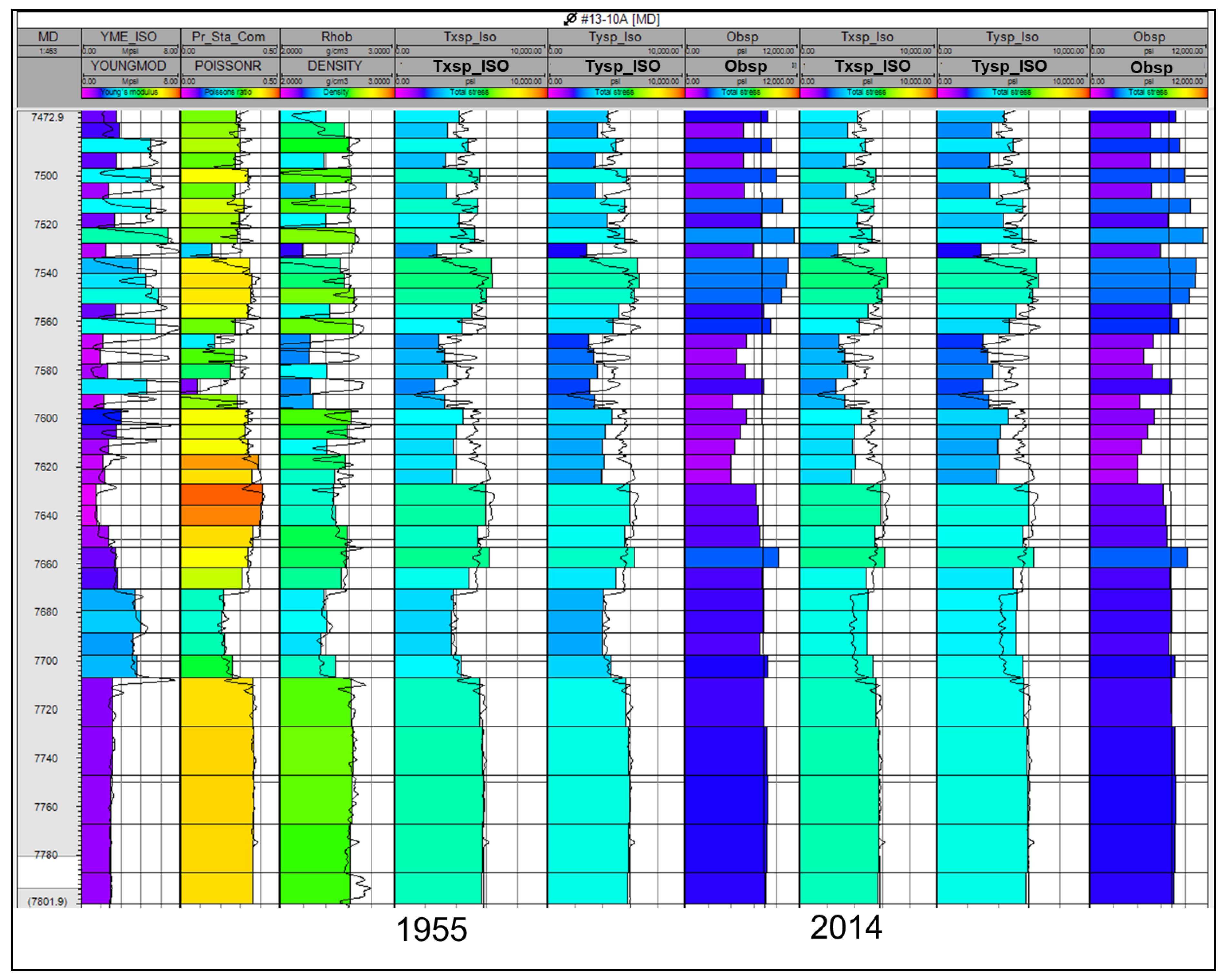
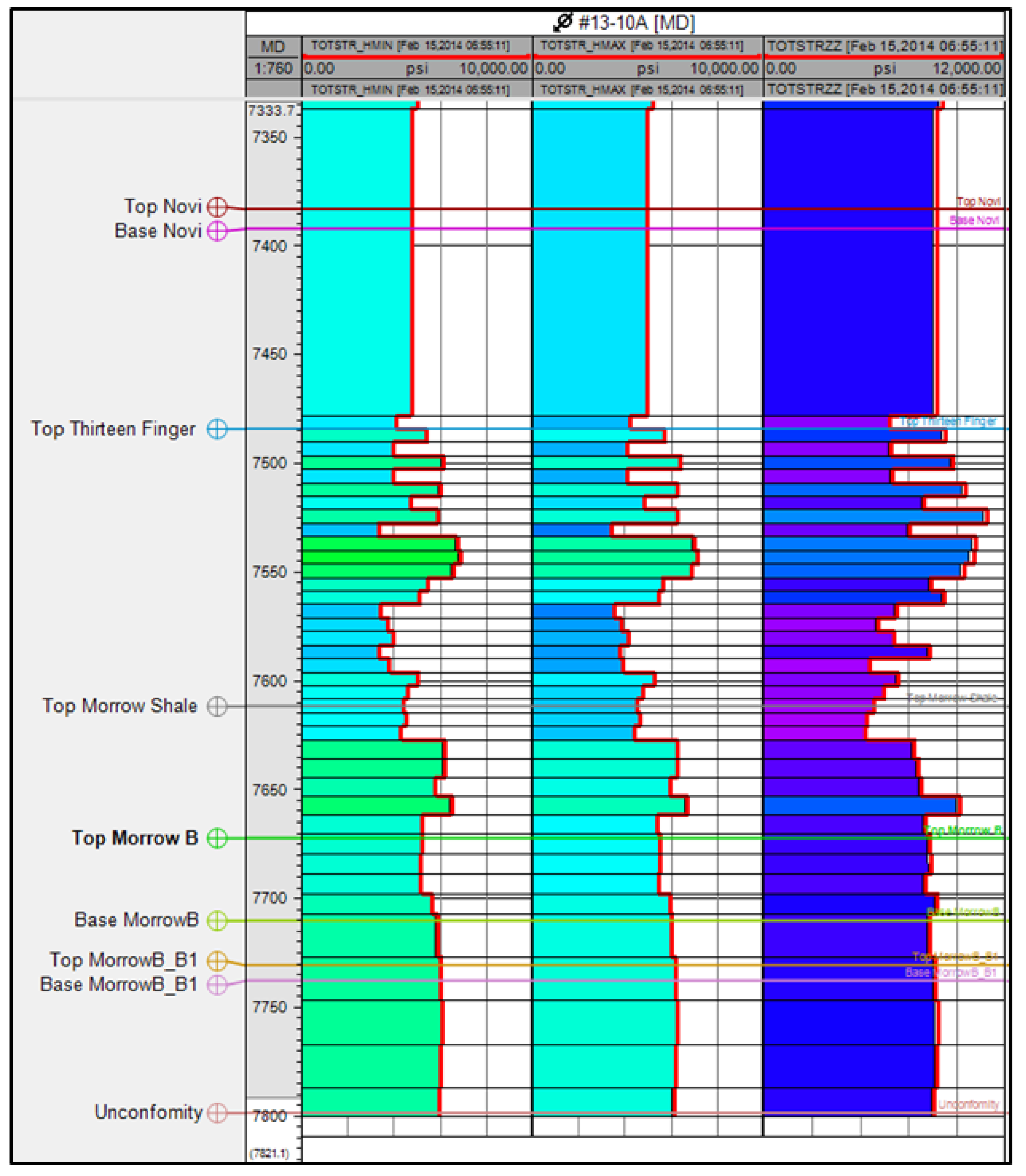

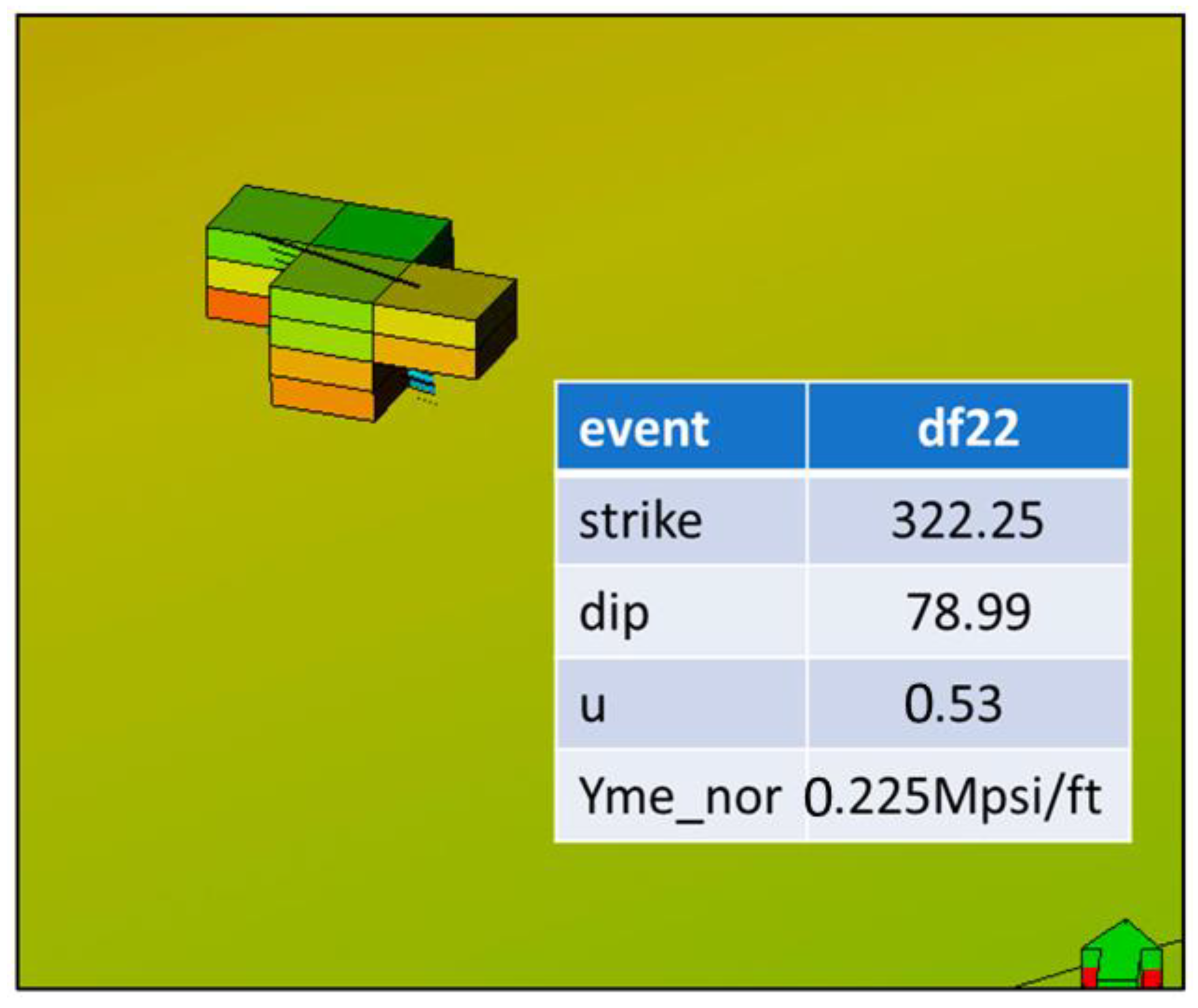

| Model | Use | Cell Size (I × J) | Total Cells |
|---|---|---|---|
| Reservoir Simulation (Geological and fluid flow model) | Simulate fluid flow. Model pore pressure changes over time | 100 × 100 | 2.7 M |
| Main Geomechanical | Analyze effect of stress/strain on rock deformation | 100 × 100 | 3.4 M |
| Sector 2 | Detail study on microseismic events | 20 × 20 | 0.651 M |
| Sector 3 | Detail study on microseismic events | 20 × 20 | 1.61 M |
| Parameter | Range | Failure Impact | Color Bar |
|---|---|---|---|
| Fracture dip | 13, 30.5, 58, 80.5, 103 | more failure towards Sh | |
| Fracture strike | 10, 45, 60, 75, 88 | more failure in mid dips | |
| Grid cell size | 20′, 50′, 100′ | more failure with smaller cell | |
| Friction coefficient (µ) | 0.36, 0.58, 0.84, 1.19 | more failure with lower µ | |
| Normal/Shear Yme (Mpsi/ft) | (176/66), (135/52), (225/83) | very small change |
| Name | Type | Min | Max | Delta | N | Mean | Std | Var | Sum |
|---|---|---|---|---|---|---|---|---|---|
| xxdiff22 | Continuous | −9.65 | 127.07 | 136.72 | 1100 | 77.20 | 39.28 | 1543.07 | 849.19 |
| yydiff22 | Continuous | −4.25 | 69.55 | 73.80 | 11.00 | 35.01 | 24.41 | 595.82 | 385.08 |
| zzdiff22 | Continuous | 89.43 | 220.73 | 131.30 | 11.00 | 173.06 | 34.34 | 1179.40 | 1903.70 |
| xydiff22 | Continuous | 1.38 | 42.45 | 41.07 | 11.00 | 14.12 | 12.41 | 154.00 | 155.33 |
| yzdiff22 | Continuous | 104.11 | 195.97 | 91.85 | 11.00 | 146.97 | 27.18 | 738.86 | 1616.65 |
| zxdiff22 | Continuous | 75.46 | 166.07 | 90.62 | 11.00 | 127.89 | 30.29 | 917.43 | 1406.84 |
| Event | Observed Mw | Modeled Mw | Strike (Degrees) | Dip (Degrees) | Coefficient of Friction | Yme Normal (Mpsi/ft) | Yme Shear (Mpsi/ft) |
|---|---|---|---|---|---|---|---|
| 1 | −0.839 | 276 | 66 | 0.36 | 0.135 | 0.051 | |
| 1 | −0.839 | −0.585 | 18 | 66 | 0.36 | 0.135 | 0.051 |
| 2 | −0.433 | 79 | 24 | 0.36 | 0.225 | 0.083 | |
| 2 | −0.433 | −0.553 | 322 | 79 | 0.36 | 0.225 | 0.083 |
Disclaimer/Publisher’s Note: The statements, opinions and data contained in all publications are solely those of the individual author(s) and contributor(s) and not of MDPI and/or the editor(s). MDPI and/or the editor(s) disclaim responsibility for any injury to people or property resulting from any ideas, methods, instructions or products referred to in the content. |
© 2023 by the authors. Licensee MDPI, Basel, Switzerland. This article is an open access article distributed under the terms and conditions of the Creative Commons Attribution (CC BY) license (https://creativecommons.org/licenses/by/4.0/).
Share and Cite
Acheampong, S.A.; Ampomah, W.; Lee, D.; Eastwood-Anaba, A. Coupled Hydromechanical Modeling and Assessment of Induced Seismicity at FWU: Utilizing Time-Lapse VSP and Microseismic Data. Energies 2023, 16, 4163. https://doi.org/10.3390/en16104163
Acheampong SA, Ampomah W, Lee D, Eastwood-Anaba A. Coupled Hydromechanical Modeling and Assessment of Induced Seismicity at FWU: Utilizing Time-Lapse VSP and Microseismic Data. Energies. 2023; 16(10):4163. https://doi.org/10.3390/en16104163
Chicago/Turabian StyleAcheampong, Samuel Appiah, William Ampomah, Don Lee, and Angus Eastwood-Anaba. 2023. "Coupled Hydromechanical Modeling and Assessment of Induced Seismicity at FWU: Utilizing Time-Lapse VSP and Microseismic Data" Energies 16, no. 10: 4163. https://doi.org/10.3390/en16104163






